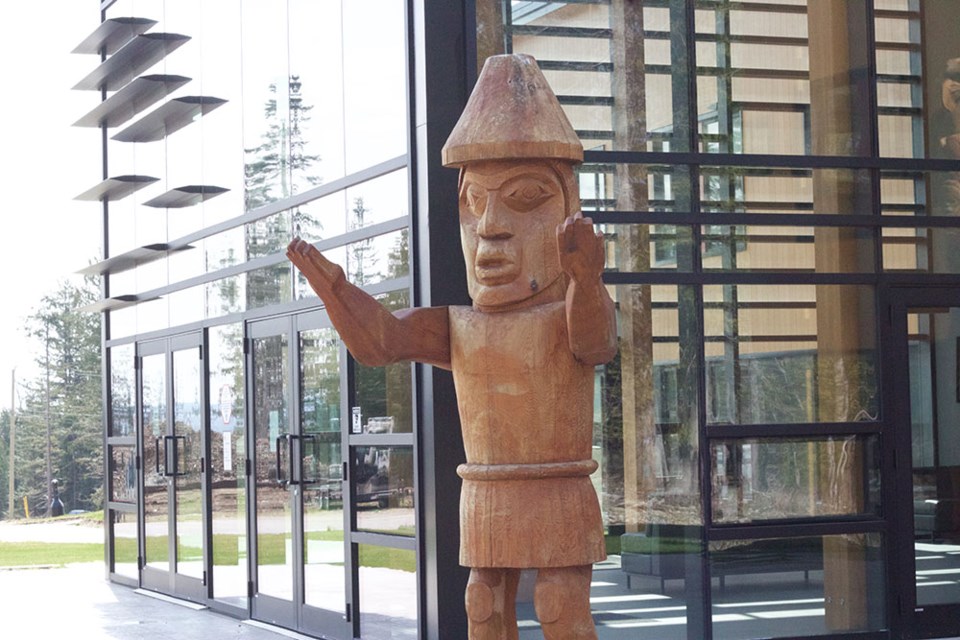The following excerpts are taken from a report called “Israel Wood Powell’s Legacy”, graciously researched and prepared by team members at KnowHistory: Historical Services (KnowHistory.ca) for Tla’amin Nation and its shared communities to be equipped with the facts concerning Powell’s work and legacy in Tla’amin territory, across the province and country, and the impacts of such. The full report is available at thenamematters.org/read.
“…to ‘civilize’ meant to remove Indigenous culture, religious practices, education and government structures, and replace them with Euro-Christian ones.”
Powell became superintendent of Indian affairs for British Columbia in 1872. For 17 years, his work centred on pursuing policies aimed at assimilating (“civilizing”) Indigenous peoples into settler Canadian society.
The potlatch
The potlatch is a cornerstone of the economic and social systems of First Nations of the northwest coast. In his first annual report as superintendent, Powell advised that “the government should adopt every practicable means to put a stop to the custom.” For Powell, the potlach would hinder proper “civilizing.”
In Powell’s view, the federal government’s response to “take steps to suppress the potlatch” was ineffective. He lobbied his colleagues in Ottawa to make it a priority legislation. In 1884, the Indian Act was amended, making the potlatch illegal, with a maximum penalty of six months in jail for any person caught participating.
The potlatch ban lasted from 1884 to 1951. While many families and communities defied the ban, they did so under the threat of imprisonment and heavy fines and the seizure of their goods and cultural property. This ban had significant disruption to the economies and cultures that sustained First Nations in the region since time immemorial.
While coastal communities have worked to repair the damage left by this and other policies aimed at extinguishing their cultural expression, the loss of the potlatch for generations of Indigenous community members remains a painful legacy.
Residential schools
Early in his career as superintendent, Powell took up the cause of what he viewed as the imperative to educate and “civilize” Indigenous children. Residential schools, created to eradicate Indigenous identity, were often places of violence and abuse.
Powell focused on the importance of establishing industrial education schools in isolated areas to turn Indigenous children into what he referred to as “useful members of society.” It was imperative, for Powell, that children be disconnected from kin and community for the effects of “civilizing” to take hold.
He sought to establish several boarding schools across the province and particularly pushed for creating a school in Kamloops to address communities in the province’s interior. A school opened in Kamloops in 1890 and became one of the largest residential schools operated by Indian Affairs.
The impact of residential schools persists today, most deeply for Indigenous people, yet far-reaching, beyond the borders of this nation as we mourn and grieve together the “discovery” of unmarked burials on the site of these schools, all the children who were never to return home.
The land question
The 15,000-acre parcel of land known as Lot 450, situated on traditional Tla’amin, Klahoose and Homalco territory and encompassing several traditional villages and seasonal sites, continues to be a site of contention.
Land speculator and Victoria politician Robert Paterson Rithet purchased the timber lease under “dubious circumstances” in 1874. Tla’amin expressed its concerns over logging around their villages to Indian land commissioner Gilbert Malcolm Sproat.
Sproat agreed that the government should cease sales of the Tla’amin territory before official surveys could be made of their reserves. When Sproat brought these complaints forward to Powell, the superintendent was dismissive of Sproat and Tla’amin’s concerns and dissuaded the commissioner from visiting Tla’amin to attempt a compromise.
Lot 450 and the lands of the Tla’amin, Klahoose and Homalco nations were highly sought after for their economic potential and probably represented areas of potential industry to Powell, who was firmly in favour of the “civilizing” effects of industry on Indigenous peoples.
Collections
Powell was a prolific collector for both personal and institutional use. In 1873, he recommended the province to begin amassing items such as art and other cultural property to form a provincial collection. He was given collection assignments from the Montreal Geological and Natural History Museum in 1879 and accumulated more than 350 items while completing an inspection tour as part of his duties as superintendent on the naval ship HMS Rocket.
Between 1880 and 1885, Powell collected objects requested by the American Museum of Natural History (AMNH), including skulls, objects of worship and stone tools.
Powell’s collection for AMNH numbered 791 pieces, including a 68-foot-long war canoe collected from the Haida Gwaii islands. This canoe remains in the AMNH collection, despite requests from the Haida for its return as part of larger repatriation efforts spearheaded by Indigenous communities to correct these misappropriations of their cultural property.
Powell was able to amass collections for personal and institutional means, largely through his influence as superintendent. These items are still alienated from the communities they were “collected.”
Harmful policies
In his 17-year tenure as superintendent of Indian affairs for BC, Powell drove these harmful policies forward through his reports to Ottawa and correspondence with federal and provincial lawmakers. His work and legacy were ultimately part of a system whose primary goal was to extinguish Indigenous culture and identity.
These harms continue today in many ways, one being through memorialization of individuals such as Powell in place names.



